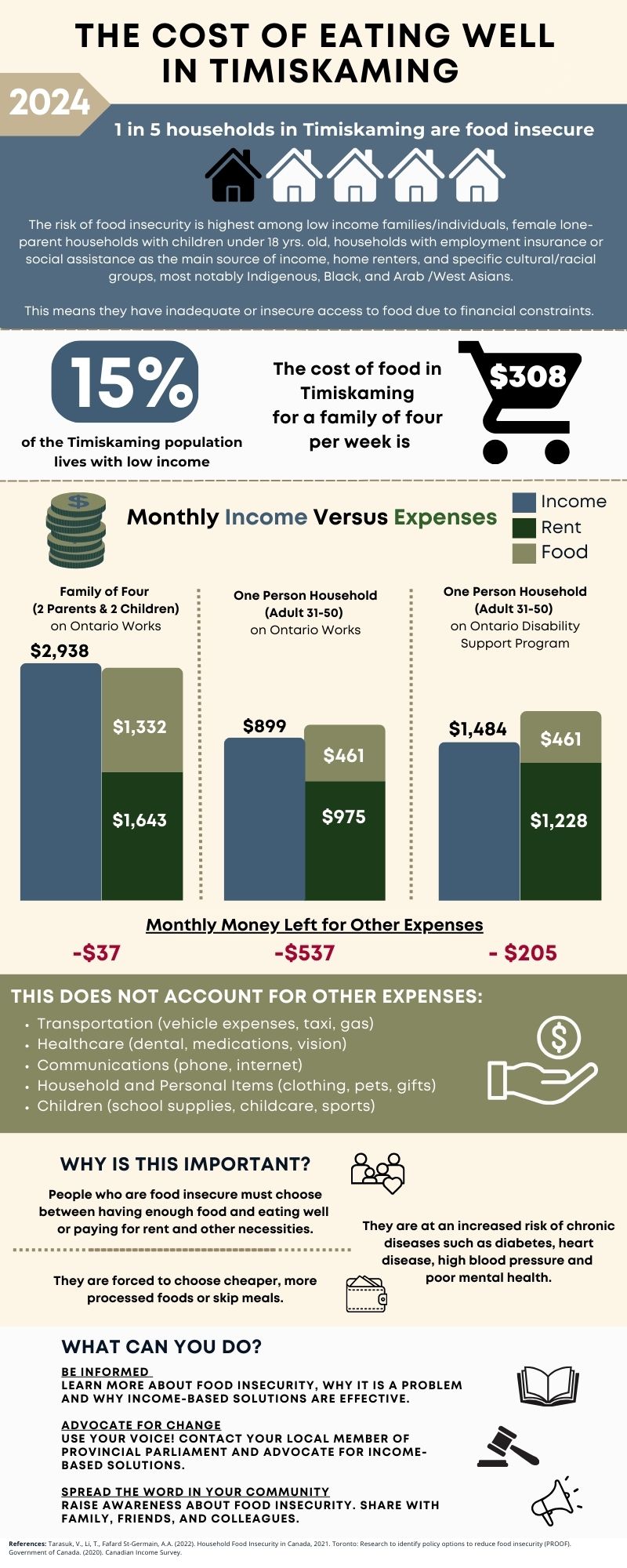Food Insecurity in Timiskaming
Food insecurity happens when a person does not have enough money to feed themselves and their family. The typical strategies used to solve this problem focus on food charity and community support (e.g., food banks). However, these only give temporary relief to families living with food insecurity. We need solutions that focus on the main cause of the problem: poverty.
Click here for more information on the Nutritious Food Basket survey and cost of food in Timiskaming.
Check the infographic below to learn more about food insecurity in Timiskaming, including the cost of food, and why this is an important problem to solve.

What can be done to help?
Being poverty the main cause of food insecurity, the best solutions focus on increasing people’s income. Some examples:
- A basic income for everyone (more info here)
- Social assistance rates that match the real cost of living
- More good jobs with realistic wages and added benefits
In Timiskaming, 15% of our families live with low-income. We need to advocate for these income-based strategies, to ensure that everyone has enough money to pay for their expenses and is able to be part of our communities.
There are actions we can take:
Local Employers
- Promote and/or support free income tax clinics for those living in low-income households.
- Adopt living wage policies to ensure
employees can afford basic necessities.
- Provide health benefits, paid sick leave, and childcare support to employees.
- Participate in campaigns advocating for higher minimum wages to support workers' ability to meet living costs.
- Offer flexible service hours so individuals don’t have to take time off work to attend appointments.
- Collaborate with community programs that
address the root causes of HFI, supporting systemic solutions.
Municipality
-
Continue to implement the
Timiskaming District Community Safety and Wellbeing Plan to address poverty through strategies like BIG, living wages, and
affordable transportation
-
Shift to responses that are
income-based rather than food-based, helping with
basic needs in a way that enhances choice and dignity.
-
Implement living wages
aligned with the cost of living in northern Ontario
to address regional disparities.
-
Advocate to increase social
assistance rates to reflect the cost of living and for
Basic Income Guarantee (BIG) initiatives.
-
Invest in affordable housing
and childcare to reduce economic pressures on
low-income families.
-
Use tools like the
Nutritious Food Basket to inform local policies and
raise awareness about food insecurity.
Provincial Government
-
Legislate targets to reduce
food insecurity as part of the Ontario Poverty
Reduction Strategy.
-
Increase social assistance
rates to reflect the cost of living and index
Ontario Works rates to inflation.
-
Set a minimum wage that aligns with Ontario’s living costs and supports employment stability.
-
Investigate the creation of
a guaranteed living wage (basic income) in Ontario.
Federal Government
-
Implement income-based
policies, such as increasing tax credits for
low-income households or lowering tax rates for the lowest-income households.
-
Expand the Canada Child
Benefit and consider implementing a Basic Income
Guarantee (BIG) for individuals aged 18-64 years.
Schools
-
Consider dignity, equity,
and inclusion for activities and programs. Assess
whether activities may unintentionally make students experiencing food
insecurity feel excluded or judged.
-
Support families
experiencing food insecurity with access to
income-based supports through referral to free tax clinics and local community
supports whenever possible, or advocate for such programs if they do not exist.
a. Example: Set up tables with information
about program and services available at school events such as parent teacher
interview or sharing information in the school newsletter.
Community Groups/Food Charities
-
Engage in advocacy
to support initiatives that provide income-based solutions rather than relying solely on temporary relief.
-
Collaborate with community
partners from various sectors, especially
racialized communities, to address HFI and systemic oppression.
-
Strengthen relationships
with local Indigenous communities to better
understand their needs regarding food security and sovereignty, and support
Indigenous-led food initiatives.
-
Partner with others in the
community to connect clients to income-based
programs and services that help households access eligible income benefits and
supports.
-
Consider ways to make food
programs more accessible and inclusive by reducing
barriers.
a. Examples: extending service hours,
providing alternative pick-up locations, offering delivery services, creating
less intrusive screening process for eligibility by asking less information to
prove eligibility to reduce stigma or burden on the clients.
Media
- Raise awareness about the prevalence, root causes, and impact of HFI, as well as
effective interventions to build public understanding and support.
Healthcare Providers
- Support Indigenous cultural safety training for staff to increase awareness, promote self-reflection, and
foster continuous learning on cultural competence in food security.
- Reduce stigma by openly acknowledging
that household food insecurity and financial strain can affect health and
well-being and normalize conversations about financial strain by asking
questions like whether someone has difficulty making ends meet at the end of
the month. This can help clients feel validated and normalize the conversation
about financial strain, leading to better referrals to appropriate resources.
- Assess for financial strain during one-on-one interactions to better understand clients’ circumstances.
- Understand that asking about financial strain is not about solving food insecurity or financial problems but about understanding how a household's financial situation impacts their health and living situation. This helps providers create realistic care plans.
20250606/cb:tr